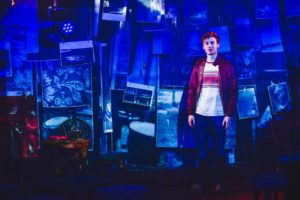 (5 / 5)
(5 / 5)
Kevin Jones’ monologue Cardiff Boy is a nostalgic jump into the 90’s with a story as relevant today as it was in the 90’s. A story of male friendship that explores toxic masculinity with a killer 90’s soundtrack.
Narrated by “the quiet one” of the group, the story follows a group of young Cardiff lads as we join them on a night out. The use of set, sound and lighting design really add to Jones’ descriptive and emotive piece, which is guided well by director Matthew Holmquist and actor Jack Hammett.
Jones’ writing in this piece has its strength in the language. Whilst the plot is fairly basic, it is the expression of the characters that really stands out. Jones uses a clever mix of comedy and archetypal characters to juxtapose the hard hitting moments of the play. This works very well and makes the play relatable, enjoyable whilst also saying something unique.
There’s more you want to know about the characters and paths that are left unexplored. But not in an unsatisfying way. Details such as the protagonist’s relationship with his father is touched upon, but quickly brushed over by the protagonist. A detail that could be explored, but the lack of clarity of which is harrowingly too real for many young men.
When the audience enter the space of The Other Room, we leave behind Porters, the pub within which the theatre resides. However, with Cardiff Boy, The Other Room literally feels like the other room of the pub, such is the strength of the set design.

Sitting down you’re greeted by benches and chairs scattered throughout the room, with tables on which to rest your drinks. And as Hammett wanders between you and the other audience members, it is hard not to feel a strong sense of place.
This is heightened with the hanging photographs of 90’s Cardiff, which act as a sort of scrapbook of the protagonist’s photography collection. Photography and perception is used at various times by the protagonist to set the scene, with the city and locations generally described in great detail. Looking around at these fragments of Cardiff hanging from the ceiling, creates a very evocative feeling that makes it easy to get drawn in.
The directing of Matthew Holmquist is another strength of this piece. Not an easy piece to take on, such is the temperamental nature of the script. Without a brave director, that temperament could easily become a major flaw. But, the tone of the piece is handled brilliantly by Holmquist who allows the moments of emotion time to breath, without letting them take over.
Jack Hammett does a good job of portraying the protagonist and his mates as he bops around the room. In particular moments of vulnerability, which defines his “quiet” character, stand out. Ultimately a play about difference in men, Hammett does a great job in portraying this.
The use of sound is crucial to this play, and it doesn’t fail to impress. The soundtrack is obviously brilliant for anyone who enjoys 90’s music. Often used to comedic effect, the music, like the photographs, has a deeper meaning to the protagonist of the piece. Sound is also key in setting the scene and does so well.
The only issue for sound designer Joshua Bowles to work on would be that the level of the sound often drowns out Hammett’s voice. On occasion this works, for example in the club, where you can never hear anyone anyway, however, probably an occurrence too regular were that the desired effect.

The use of lighting from Ryan Stafford is understated. Often going unnoticed until you try to see it, the lighting adds to the overall piece well. A tough play for lighting, as the stage is the entire room, Stafford manages to keep it effective without distracting. Even when there are flashing lights, you barely notice it because the music, direction and acting are all working together with the lighting to set the scene.
Perhaps this is the biggest compliment to Cardiff Boy and Red Oak Theatre as a wider company. A company that views the roles of the designers as importantly as the director, writer or actor. Something that is weirdly rare when you consider how well it has worked in Cardiff Boy and how vital these professions are to the theatre industry.
It’s good also to see that with this in mind, Red Oak are committed and passionate about developing young artists with a paid assistant director (Nerida Bradley) and assistant designer (Lauren Dix). A company no doubt restricted by a budget won’t always do this, so it’s nice to see Red Oak committing to young artists in this way.
Along with this, it is heartening for a piece that started at a scratch night, to grow into such a strong piece of theatre. Again showing Red Oak’s commitment to new work and new artists.
Overall, Cardiff Boy is a wonderful production. It’s hard to say anything stands out in this production as everything works so well together to achieve its aim. However, April Dalton’s design, assisted by Lauren Dix, is phenomenal and deserves recognition.
The play’s greatest strength is the team behind it because with another team, and another company, Jones’ emotive script could be easily forgotten.
Cardiff Boy by Kevin Jones
Presented by Red Oak Theatre
Running From: 30 October – 11 November 2018
Performed at The Other Room, Cardiff
Director: Matthew Holmquist
Cast: Jack Hammett
Designer: April Dalton
Lighting Designer: Ryan Stafford
Stage Manager: Joshua Bowles
Sound Designer: Joshua Bowles
Producer: Ceriann Williams
Assistant Director: Nerida Bradley
Assistant Designer: Lauren Dix
